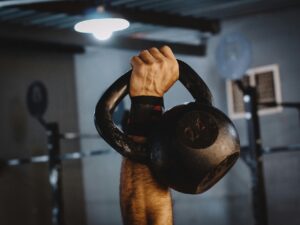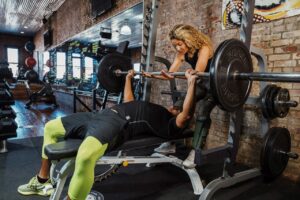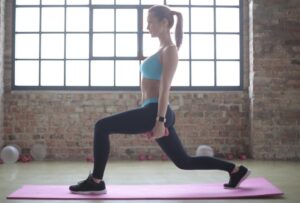So, you’re looking for some simple and effective home workout routines? But you’re unsure where to start and if home training is even worth it.
If so, read on because we are diving into eight fantastic home workouts for all levels and some tips to make your training more effective.
1. Dumbbell Push/Pull/Legs Split
The push/pull/legs split is popular because it’s effective, flexible, and easy to understand. It organizes your training into three types of workouts:
- Push, where you train the chest, shoulders, and triceps
- Pull, where you train the back and biceps
- Legs, where you train the muscles of the lower body
The following is a 3-day version, where trainees typically take a day to recover between workouts. Here is how it might look with only dumbbell exercises:
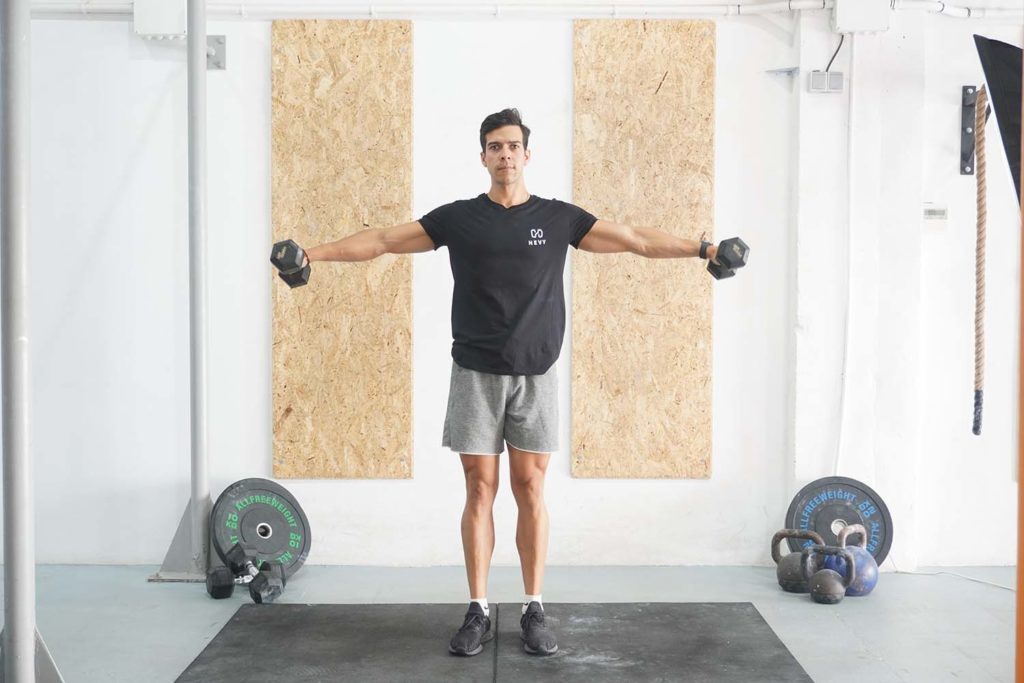
| Workout 1 – Push | |||
| Exercise | Sets | Reps | Rest (mins) |
| Floor Press (Dumbbell) | 3-4 | 10-12 | 2 |
| Shoulder Press (Dumbbell) | 3-4 | 10-12 | 2 |
| Lateral Raise (Dumbbell) | 3 | 12-15 | 1.5 |
| Triceps Extension (Dumbbell) | 3 | 15-20 | 1.5 |
| Workout 2 – Pull | |||
| Exercise | Sets | Reps | Rest (mins) |
| Bent Over Row (Dumbbell) | 3-4 | 10-12 | 2 |
| Dumbbell Row | 3-4 | 12-15 | 2 |
| Shrug (Dumbbell) | 3 | 12-15 | 1.5 |
| Bicep Curl (Dumbbell) | 3 | 15-20 | 1.5 |
| Workout 3 – Legs | |||
| Exercise | Sets | Reps | Rest (mins) |
| Goblet Squat | 3-4 | 10-12 | 2 |
| Lunge (Dumbbell) | 3 | 10-12 (per leg) | 2 |
| Romanian Deadlift (Dumbbell) | 3-4 | 10-12 | 2 |
| Single Leg Standing Calf Raise (Dumbbell) | 3 | 15-20 | 1.5 |
Equipment needed: a pair of adjustable dumbbells
Duration: roughly 45 minutes per session, not including the warm-up and cooldown
Level: beginner, early intermediate
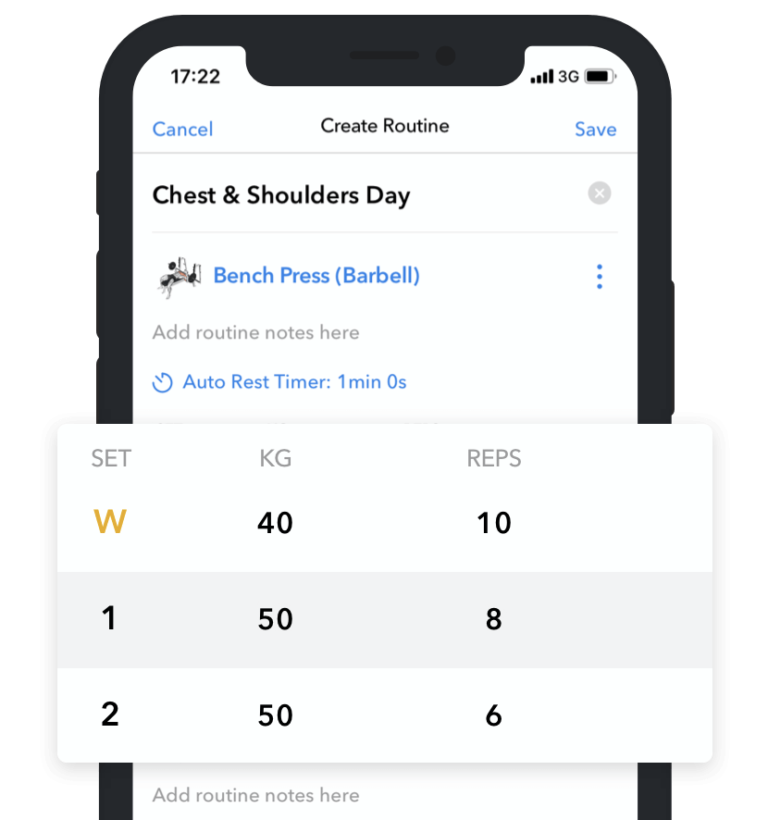
Hevy – Workout Tracker







Hevy – Workout Tracker
Create and log your pr workout with Hevy and track your progress
2. Resistance Bands + Dumbbells Upper/Lower Split
The upper/lower split is another popular way to organize your weekly training. Here, the ideal frequency is four weekly workouts: two for the upper body and two for the legs.
Upper-body workouts tend to be longer because there are more muscle groups to train. In contrast, leg sessions are quicker.
The following is a 4-day version of the upper/lower split where we use resistance band and dumbbell exercises.
| Workout 1 – Upper A | |||
| Exercise | Sets | Reps | Rest (mins) |
| Floor Press (Dumbbell) | 3 | 8-10 | 2-2.5 |
| Bent Over Row (Dumbbell) | 3 | 8-10 | 2-2.5 |
| Shoulder Press (Dumbbell) | 3 | 10-12 | 2 |
| Lat Pulldown (Band) | 3 | 12-15 | 2 |
| Chest Fly (Band) | 2-3 | 15-20 | 1.5 |
| Hammer Curl (Dumbbell) | 2-3 | 15-20 | 1.5 |
| Tricep Extension (Dumbbell) | 2 | 15-20 | 1.5 |
| Face Pull (Band) | 2 | 20-25 | 1 |
| Workout 2 – Lower A | |||
| Exercise | Sets | Reps | Rest (mins) |
| Goblet Squat | 3 | 8-10 | 2 |
| Romanian Deadlift (Dumbbell) | 3 | 10-12 | 2 |
| Lunge (Dumbbell) | 3 | 10-15 (per leg) | 2 |
| Lateral Band Walks | 2-3 | 12-15 (in each direction) | 1.5 |
| Single Leg Standing Calf Raise (Dumbbell) | 3 | 15-20 | 1.5 |
| Workout 3 – Upper B | |||
| Exercise | Sets | Reps | Rest (mins) |
| Bent Over Row (Band) | 3 | 12-15 | 1.5 |
| Decline Push Up | 3 | RPE 8-9 (leave 1-2 reps in the tank) | 2 |
| Overhead Press (Dumbbell) | 3 | 10-12 | 2 |
| Lat Pullover (Band) | 3 | 15-20 | 1.5 |
| Chest Fly (Band) | 2-3 | 15-20 | 1.5 |
| Bicep Curl (Dumbbell) | 2 | 15-20 | 1.5 |
| Tricep Kickback (Dumbbell) | 2 | 15-20 | 1.5 |
| Workout 4 – Lower B | |||
| Exercise | Sets | Reps | Rest (mins) |
| Bulgarian Split Squat | 3 | 10-12 (per leg) | 2 |
| Single Leg Glute Bridge | 3 | 12-15 (per leg) | 2 |
| Jump Squat | 3 | RPE 8-9 (leave 1-2 reps in the tank) | 2 |
| Single Leg Standing Calf Raise (Dumbbell) | 3 | 12-15 | 1.5 |
| Crunch (Weighted; Dumbbell) | 3 | 12-15 | 1.5 |
Equipment needed: pair of adjustable dumbbells, resistance band set, a door anchor (for the bands; typically comes with band sets), and a sturdy chair
Duration: 60-70 minutes for upper body sessions, 45-55 minutes for lower body workouts
Level: intermediate
3. Full-Body 3-Day Split
Full-body training has been around for a long time and is still popular today. The approach works particularly well for beginners because they can accumulate enough volume to grow.
Also, trainees get to perform the core compound lifts more frequently to build the necessary skills and get stronger more quickly.
As the name suggests, the goal of full-body training is to directly train the majority of large muscle groups during each session.
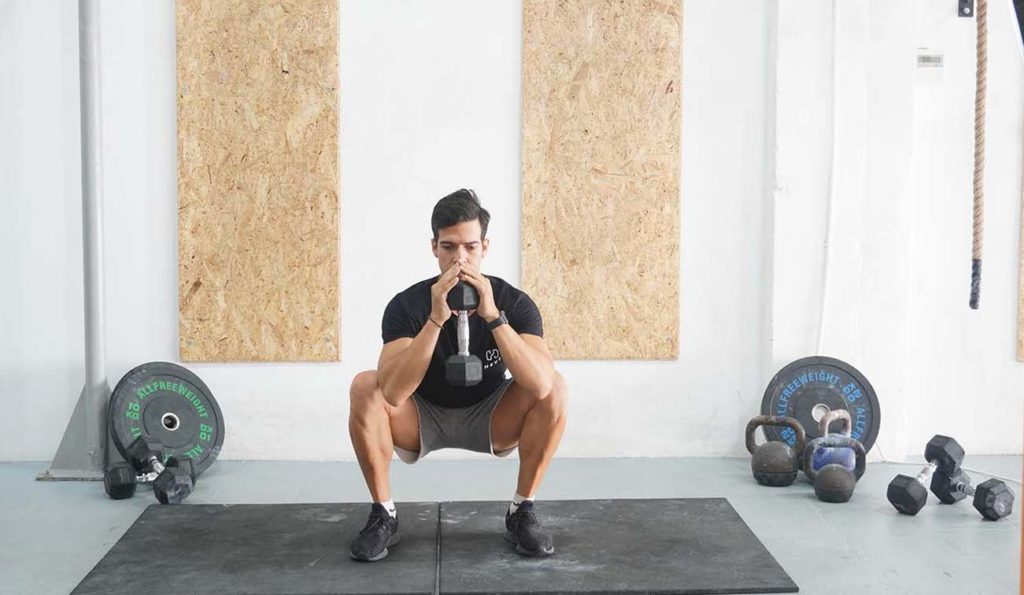

| Workout 1 – Full Body | |||
| Exercise | Sets | Reps | Rest (mins) |
| Goblet Squat | 5 | 8-10 | 2 |
| Floor Press (Dumbbell) | 5 | 10-12 | 2 |
| Bent Over Row (Dumbbell) | 5 | 10-12 | 2 |
| Glute Bridge | 4 | Close to failure (RPE 8.5-9) | 1.5 |
| Chest Fly (Band) | 3 | 15-20 | 1.5 |
| Workout 2 – Full Body | |||
| Exercise | Sets | Reps | Rest (mins) |
| Dumbbell Row | 5 | 8-10 (per side) | 2 |
| Decline Push Up | 5 | Close to failure (RPE 8.5-9) | 2-2.5 |
| Bicep Curl (Dumbbell) | 3-4 | 12-15 | 1.5 |
| Tricep Pushdown (Band) | 3-4 | 15-20 | 1.5 |
| Lateral Raise (Dumbbell) | 3-4 | 15-20 | 1.5 |
| Single Leg Standing Calf Raise (Dumbbell) | 3-4 | 15-20 | 1 |
| Workout 3 – Full Body | |||
| Exercise | Sets | Reps | Rest (mins) |
| Bulgarian Split Squat | 5 | 10-12 (per leg) | 2 |
| Overhead Press (Dumbbell) | 5 | 10-12 | 2 |
| Push Up | 5 | Close to failure (RPE 8.5-9) | 2-2.5 |
| Romanian Deadlift (Dumbbell) | 3-4 | 10-12 | 2 |
| Lat Pulldown (Band) | 3-4 | 15-20 | 1.5 |
| Shrug (Dumbbell) | 3 | 15-20 | 1.5 |
Equipment needed: two adjustable dumbbells, a set of resistance bands, a door anchor (for the bands; typically comes with band sets), and a sturdy chair
Duration: 60-75 minutes per workout
Level: early to mid intermediate
4. Beginner Bodyweight Muscle-Builder (Full Body)
Bodyweight squats and similar exercises might often seem ineffective. After all, how can your body weight provide the same resistance and, by extension, tension for your muscles as a barbell loaded with 200, 300, or even 400+ lbs?
The truth is that bodyweight workouts can be effective, especially for beginners, so long as trainees:
- Focus on progressive overload (gradually doing more demanding workouts)
- Train with proper form
- Feel the correct muscles activating on each rep
With that in mind, let’s review a home bodyweight workout for beginners to build muscle.
| Exercise | Sets | Reps | Rest (mins) |
| Negative Pull Up | 3 | 4; 5-sec descends | 2 |
| Squat (Bodyweight) | 3 | 12 | 1.5 |
| Glute Bridge | 3 | 15 | 1.5 |
| Kneeling Push Up | 3 | 8 | 1.5 |
| Lunge | 3 | 8-10 (per leg) | 1.5 |
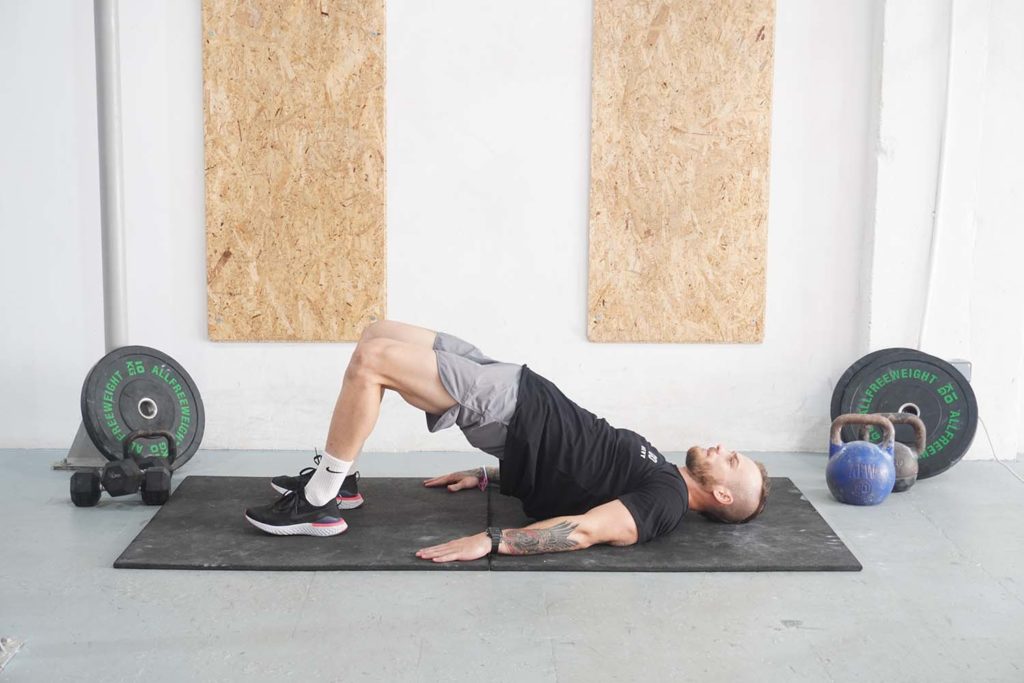

A simple way to progress is to gradually increase the number of reps and the duration of the negatives during pull-ups.
Let’s take the negative pull-up as an example. The following progression scheme assumes you perform the above workout twice per week. So:
| Workout 1 | 4 reps, 5-second descends | Week 1 |
| Workout 2 | 5 reps, 5-second descends | |
| Workout 3 | 6 reps, 5-second descends | Week 2 |
| Workout 4 | 7 reps, 5-second descends | |
| Workout 5 | 8 reps, 5-second descends | Week 3 |
| Workout 6 | 9 reps, 5-second descends | |
| Workout 7 | 9 reps, 5-second descends | Week 4 |
| Workout 8 | 10 reps, 5-second descends | |
| Workout 9 | 10 reps, 6-second descends | Week 5 |
| Workout 10 | 10 reps, 6-second descends | |
| Workout 11 | 10 reps, 7-second descends | Week 6 |
| Workout 12 | 10 reps, 7-second descends | |
| Workout 13 | 10 reps, 8-second descends | Week 7 |
| Workout 14 | 10 reps, 8-second descends | |
| Workout 15 | 10 reps, 9-second descends | Week 8 |
| Workout 16 | 10 reps, 9-second descends |
As you can see, there is nothing fancy about it. The goal is to increase the amount of work you do from workout to workout (or week to week, in some cases). That way, when you look 6, 12, or 18+ weeks back, you can see significant improvements in your performance.
Week 2 looks identical to week 1, but week 8? There is an apparent increase in the training volume.
Do the same for all the exercises, and you will see impressive results in strength and muscle growth.
Equipment needed: pull-up bar and an exercise mat
Duration: 30-35 minutes per workout
Level: beginner
5. Advanced Bodyweight Home Workout Routine for Growth
Putting together a bodyweight routine for growth for advanced trainees is more difficult but not impossible. Here are a few things it needs to cover:
- Training volume generally needs to be higher
- The movements need to be more challenging to create the same stimulus with fewer reps
- Trainees must get closer to failure more frequently
Even then, results tend to come more slowly and unpredictably.
| Type | Exercise | Sets | Reps | Rest (mins) |
| Set | Pull Up | 4-5 | To an RPE 8; last set to failure | 2-2.5 |
| Set | Assisted Pistol Squat | 4-5 | To an RPE 8; last set to failure | 2 |
| Set | Chest Dip | 4-5 | To an RPE 8; last set to failure | 2-2.5 |
| Set | Nordic Hamstring Curls | 4 | To an RPE 8; last set to failure | 2-2.5 |
| Set | Pike Pushup | 4 | To an RPE 8; last set to failure | 2 |
| Superset | Bicep Curl (Suspension) | 3 | To an RPE 8; last set to failure | 2 |
| Tricep Extension (Suspension | ||||
| Superset | Single Leg Standing Calf Raise | 3 | All sets to failure | 2 |
| Hanging Leg Raise | To an RPE 8; last set to failure |
As far as at-home workout routines go, this is a bit more challenging because it requires some basic equipment.
However, if you’re a fan of bodyweight training and enjoy home workouts, the setup won’t cost that much. You could get a pull-up bar for a door frame or a wall-mounted one. Dip stands also don’t cost much and don’t take up a lot of space.
You can even get a wall-mounted pull-up bar with dip handles, a 2-in-1 combo.
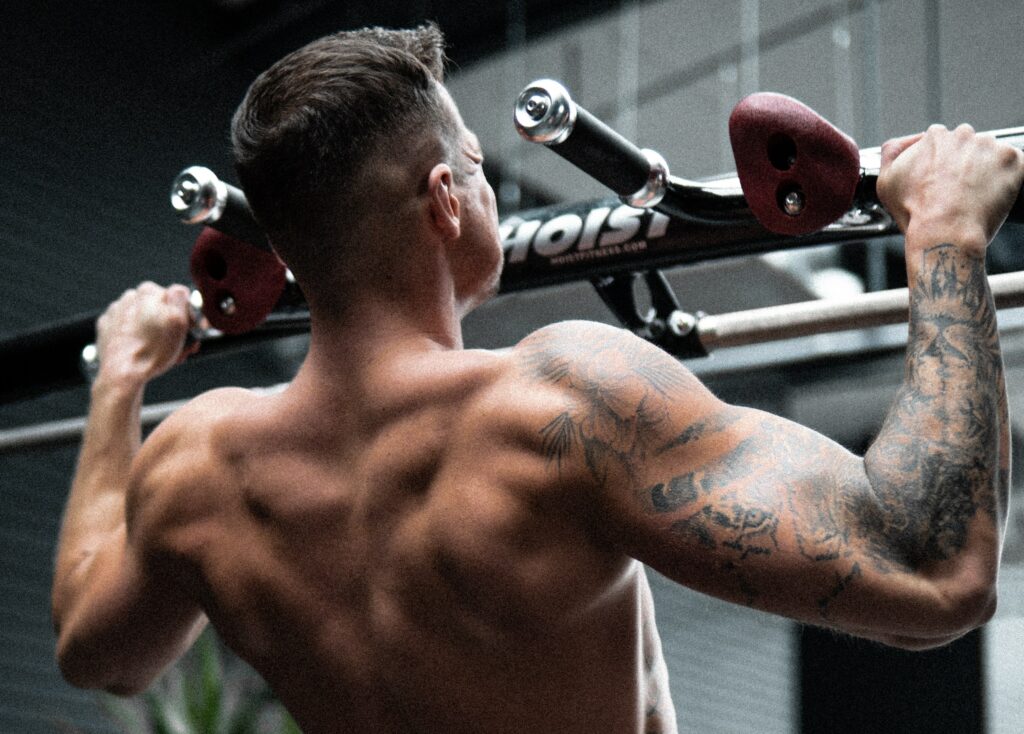

Nordic hamstring curls are also a bit challenging to do at home but well worth the try. One option is for someone to hold your ankles down while you do the exercise. Alternatively, position your feet underneath a piece of heavy furniture that can support your body weight.
You can also check out this simple setup with an old sheet.
For pike push-ups, start with your feet on the floor, aiming for 20 smooth and controlled reps. Once you can do that, elevate your feet on a stool or a chair for additional resistance.
Finally, a suspension kit (such as TRX) is another fine addition to your training tools because it doesn’t take up much space but opens the door for many exercises. If you can’t get one now, use an old sheet secured against a closed door.
Equipment needed: pull-up bar, dip stands, suspension kit (or an old sheet), and an exercise mat
Duration: 70 to 90 minutes, including a 5-minute warm-up before you start
Level: Advanced







Hevy – Workout Tracker







Hevy – Workout Tracker
Create and log your pr workout with Hevy and track your progress
6. Leg Workouts for Growth and Strength (All Levels)
We’ve covered some lower-body workouts above. This one is slightly different because we’ve shared three versions: for beginners, intermediates, and advanced trainees.
Beginner Version
| Exercise | Sets | Reps | Rest (mins) |
| Goblet Squat | 3 | 12-15 | 1.5 |
| Romanian Deadlift (Dumbbell) | 3 | 12-15 | 1.5 |
| Lunge (Dumbbell) | 3 | 12-15 (per leg) | 1.5 |
| Glute Bridge | 3 | 20-25 | 1-1.5 |
Intermediate Version
| Exercise | Sets | Reps | Rest (mins) |
| Bulgarian Split Squat | 4 | 8-10 (per leg) | 2 |
| Glute Bridge Curls | 4 | 5-15 | 2 |
| Goblet Squat | 4 | 10-12 | 2 |
| Romanian Deadlift (Dumbbell) | 4 | 12-15 | 1.5 |
| Single Leg Standing Calf Raise (Dumbbell) | 3-4 | 15-20 | 1.5 |
Advanced Version
| Exercise | Sets | Reps | Rest (mins) |
| Assisted Pistol Squat | 5 | To an RPE 8-9 | 2-2.5 |
| Nordic Hamstring Curls | 5 | To an RPE 8-9 | 2-2.5 |
| Bulgarian Split Squat | 5 | 12-15 per leg | 2 |
| Romanian Deadlift (Dumbbell) | 4 | 12-15 | 2 |
| Single Leg Glute Bridge | 4 | To an RPE 8-9 | 1.5-2 |
| Single Leg Standing Calf Raise (Dumbbell) | 4 | 15-20 | 1.5 |
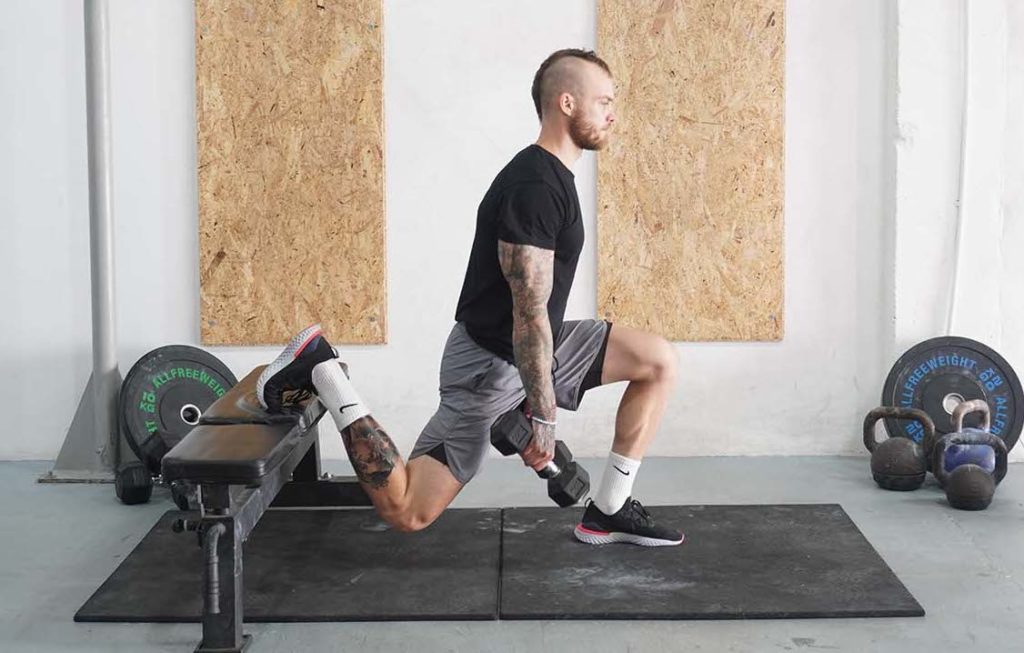

As you can see, having some basic gym equipment is of enormous help. Even a pair of dumbbells would allow you to add many exercises to your arsenal, change things up when your training gets stale, and provide a new stimulus for your muscles.
Equipment needed (beginner): a pair of adjustable dumbbells and an exercise mat
Equipment needed (intermediate): a pair of adjustable dumbbells, a pair of workout sliders, an exercise mat, and a small, flat, and sturdy surface for calf raises
Equipment needed (advanced): a pair of adjustable dumbbells, an exercise mat, and a small step for calf raises
Duration: 25 min (beginner); 45 min (intermediate); 60-75 min (advanced)
Level: beginner, intermediate, and advanced
7. 20-Minute HIIT Routine
HIIT, also known as high-intensity interval training, is not necessarily superior to long, less intense cardio sessions, such as jogging or hiking. However, it offers some unique benefits and could be an effective way for people on a tight schedule to get a productive workout in.
So, let’s review a simple and effective 20-minute HIIT workout you can do at home with some basic equipment:
The Warm Up
| Activity | Duration (seconds) | Intensity |
| Jumping jacks | 30 | Low to moderate |
| Dynamic leg swings | 30 per leg | Low, aim for a full range of motion |
| Arm circles | 30 per arm | Low, aim for slow and controlled motions |
| High knees | 30 | Low to moderate |
| Mountain climber | 30-45 | Moderate |
The Workout
| Activity | Duration (seconds) | Rest Period (seconds) | Intensity |
| Burpees | 30 | 30 | High |
| Mountain climber | 30 | 30 | High |
| Jump squats | 30 | 30 | High |
| High knees | 60 | 30 | High |
| Plank jacks | 30 | 30 | High |
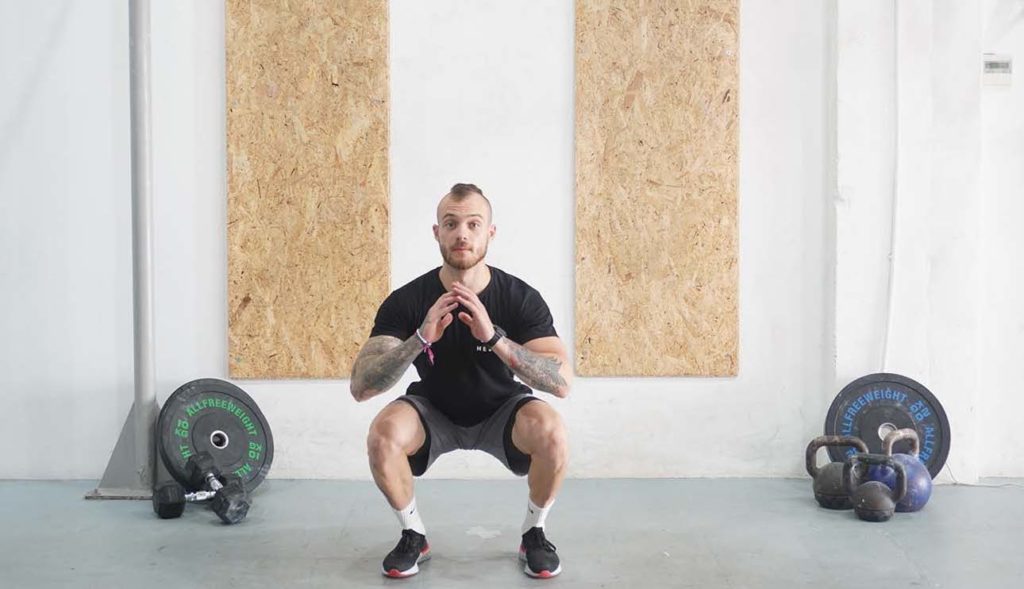

- Work your way down the list of exercises, taking the recommended 30 seconds of rest in between.
- Do each movement as quickly as possible while maintaining proper form. For instance, when doing high knees, lift each knee high enough. There is no point in shortening the range of motion to do more reps.
- Once you do all movements, recover for up to two minutes and perform two more rounds, totaling about 20 minutes.
Equipment needed: exercise mat
Duration: 25-30 minutes (including the warm-up)
Level: intermediate
8. The 7-Minute Routine
The 7-minute routine is a popular full-body workout designed to train all major muscle groups in as little time as possible.
What makes this routine great is that the exercises are sequenced in a way where they don’t over-fatigue a specific muscle group and hinder your performance. Instead, each activity targets a specific area of the body.
Plus, you don’t need any special equipment to do it.
The 7-Minute Routine in Action
| The Exercise | Duration (seconds) | Rest Period (seconds) |
| Jumping Jacks | 30 | 10 |
| Wall Sit | 30 | 10 |
| Push Up | 30 | 10 |
| Crunch | 30 | 10 |
| Step Up | 30 | 10 |
| Squat (Bodyweight) | 30 | 10 |
| Bench Dip | 30 | 10 |
| Plank | 30 | 10 |
| High Knees | 30 | 10 |
| Lunge | 30 | 10 |
| Push Ups (with rotation) | 30 | 10 |
| Side Plank | 30 | 10 |
- Go down the list of exercises.
- Perform reps steadily to maintain proper form, but don’t forget about speed. You should be able to do at least 15 solid repetitions on movements like crunches, bench dips, and lunges.
- Rest for as little as possible between movements, and don’t forget to breathe.
- Once you complete the whole round, take some time to recover and do one or two more rounds if you’re up for it and have the time.
The goal of the 7-minute routine is to give people at home an opportunity to squeeze in an effective workout. Its unique blend of strength training and cardio burns calories, making it useful for weight loss and muscle growth.
Equipment needed: a sturdy chair and an exercise mat; push-up handles can be helpful if you experience wrist pain
Duration: around eight minutes per round, not including a warm-up
Level: beginner to early intermediate
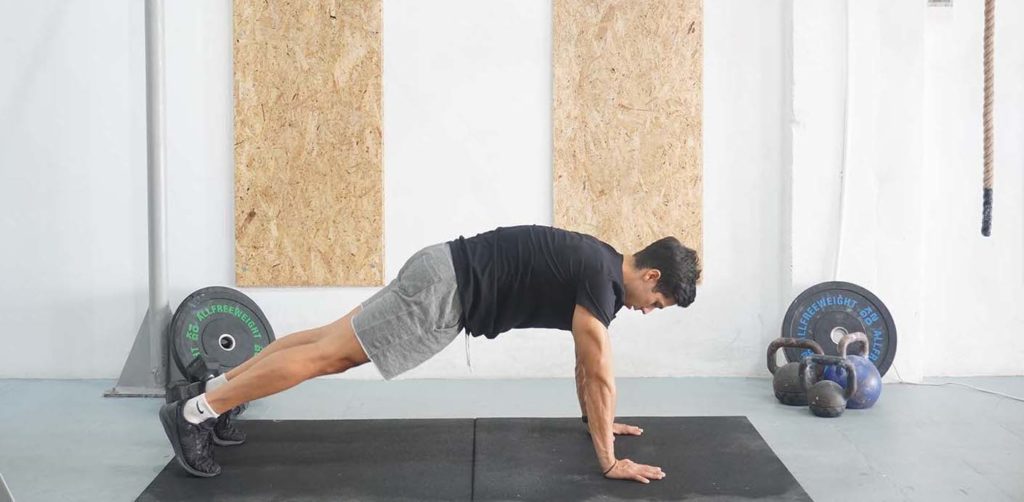

4 Tips to Make the Most of Your Home Training
1. Prioritize Proper Form
Home training often means doing bodyweight exercises, where proper form might not seem as crucial as during heavy barbell training. However, training with good technique is essential for:
- Reducing the injury risk
- Training the correct muscles
- Establishing proper motor patterns
For example, if 10 reps are all you can do with proper form, stick with that. A huge mistake trainees make is pushing beyond their capacity to do more reps, only for their technique to break down.
2. Rest Long Enough Between Sets
Research links longer rest periods with superior growth and strength gains (1, 2). One simple explanation is that by resting longer, you do each set in a more recovered state, do more reps with better form, and cause a larger disruption.
So, regardless of where you work out, take long enough breaks––typically at least 1.5 to 2 minutes, but sometimes longer.
An exception here would be circuit-style training and HIIT workouts, where the goal is to train at a quicker pace and do more volume in less time.
3. Don’t Overtrain
Most people underestimate the impact of home training and often ramp up the training volume to make up for the seemingly less effective workouts. But here’s the thing:
Home training can be just as demanding as gym workouts when done right. Muscle damage, metabolic stress, and the psychological demands of training are still present.
If the workouts are too long, too demanding, or too frequent, overtraining is possible, and you must be mindful of that fact.
4. Progress Steadily
Any type of training, be it outside, at the gym, or at home, needs one crucial ingredient to work in the long run: progressive overload.
The principle states that for positive adaptations (muscle growth, strength gains, improved endurance, etc.) to occur, we must subject ourselves to increasingly more training stress. In doing so, we force the body to adapt so it can better handle the same stress in the future.
All that means is you must increase the difficulty of your workouts over time. For instance:
- When doing bodyweight exercises, do more reps and sets, as well as more challenging movement variations
- When lifting external weights, lift more weight for more reps and sets
- When doing time-based activities, increase the duration
Related Article: Best Home Workout for Women: 7 Fantastic Options
Conclusion
Home training doesn’t get the love it deserves. Sure, it seems effective for people with a solid gym in their garage or basement, but everyone else? You’d better stick to the gym if you want true gains.
Fortunately, that isn’t the case for one simple reason:
Our muscles respond to stress and tension. So long as we can provide both and gradually increase the difficulty of our training, we can grow and get stronger.
Does that mean it’s going to be easy? No, because home training often requires creativity to work. But as you saw from the above workouts, plenty of options exist.
Check out the Hevy app if you’re looking for a simple way to put together routines like the ones above, log workouts quickly, track your progress, and see how your friends are doing.







Hevy – Workout Tracker







Hevy – Workout Tracker
Create and log your pr workout with Hevy and track your progress
FAQs
1. Can you build muscle with at-home workouts?
Yes, home training can be quite effective for growth, though it can be more challenging to progress and overload your muscles with as much weight as you can in a gym setting.
2. How long do your workouts need to be?
Beginners can see results from as little as 30 minutes of training, whereas more advanced trainees might need 60+ minutes to accumulate enough volume.
In any case, the pace and intensity of the workout will impact its duration.
3. Do you need equipment to work out at home?
You can do plenty of equipment-free exercises to grow and build strength. That said, having some basic equipment like adjustable dumbbells, resistance bands, a pull-up bar, and an exercise mat allows you to do more exercises.


